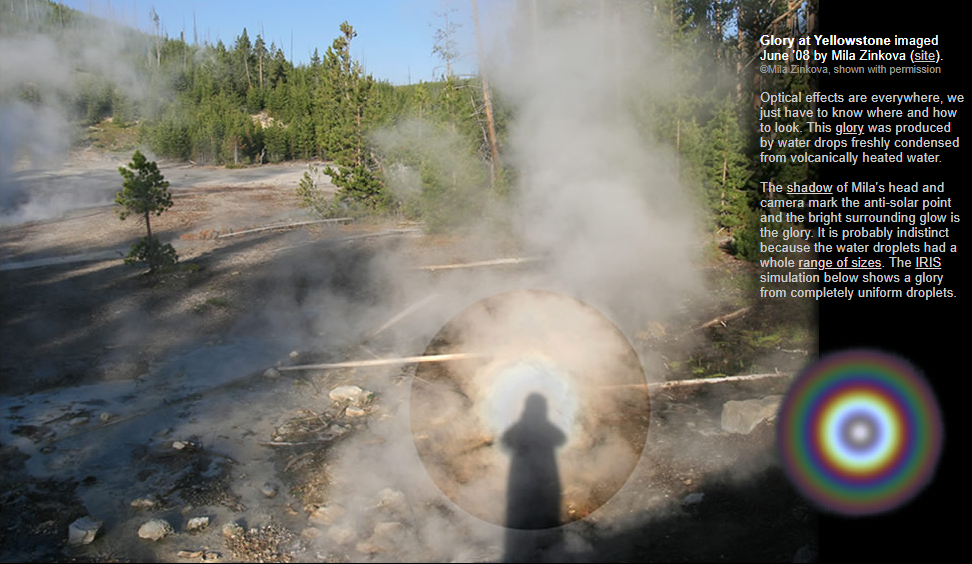Volcanic Glory
Volcanic Glory: An Astonishing Optical Phenomenon
Optical phenomena can be found in various corners of the Earth, if only we know where and how to look. One such breathtaking spectacle is the phenomenon known as "Volcanic Glory." This captivating display occurs when water droplets, freshly condensed from volcanically heated water, interact with sunlight to create a mesmerizing glow. The result is a remarkable sight that never fails to leave observers in awe.
When capturing the glory at Yellowstone National Park in June 2008, photographer Mila Zinkova inadvertently marked the anti-solar point with her head and camera's shadow. The brilliance surrounding this shadow represents the glory itself. Due to the varied sizes of the water droplets involved, the glory appears somewhat indistinct in this particular image. However, an IRIS simulation reveals what a glory would look like with completely uniform droplets, offering a clearer representation of this stunning phenomenon.
The Science Behind Volcanic Glory
To truly appreciate the beauty of the volcanic glory, it helps to understand the science behind it. When volcanic activity occurs, water is heated by the intense heat generated by the volcano. This heated water then rises into the atmosphere, where it cools and condenses into tiny droplets. These droplets act as miniature prisms, refracting and reflecting sunlight in a way that creates the glorious display.
The glory is formed through a combination of diffraction, refraction, and reflection. As sunlight passes through the droplets, it undergoes diffraction, causing it to spread out into its component colors. This dispersion creates a ring of colors around the shadow of the observer's head or any other object casting a shadow. Additionally, refraction occurs as light enters and exits the droplets, bending and changing its direction. Finally, reflection plays a role as well, with light bouncing off the inner surfaces of the droplets and contributing to the overall glow.
The Enigmatic Beauty of the Glory
The volcanic glory is a unique optical phenomenon that captivates viewers with its ethereal beauty. Its indistinct appearance, caused by the varying sizes of the water droplets involved, adds an element of mystique to the spectacle. The interplay of diffraction, refraction, and reflection creates a multi-colored halo around the shadow, adding to the enchantment.
Despite its name, the glory is not exclusive to volcanic regions. While volcanic activity does produce ideal conditions for its formation, this phenomenon can also occur in other settings where water droplets are present, such as in clouds or mist. The key factors for the glory's occurrence are the presence of sunlight, water droplets of a specific size range, and an observer positioned at the anti-solar point.
Experiencing the Volcanic Glory
If you find yourself in an area with volcanic activity or in a location where conditions are favorable for the formation of glory, you may be fortunate enough to witness this extraordinary display. To increase your chances of observing the glory, keep these tips in mind:
- Look for locations where volcanic heat causes water to rise into the atmosphere, such as geysers or hot springs.
- Position yourself at the anti-solar point, which is opposite to the direction of the sun.
- Pay attention to weather conditions and seek out moments when sunlight interacts with water droplets.
- Be patient and observant, as the glory may appear and disappear relatively quickly.
Remember, the glory is a natural phenomenon that cannot be predicted with absolute certainty. However, by being in the right place at the right time and knowing what to look for, you may be fortunate enough to witness this awe-inspiring display of nature's wonders.
Volcanic Glory: A Window into Atmospheric Optics
The volcanic glory serves as a remarkable example of the wonders of atmospheric optics. By studying and understanding this phenomenon, scientists gain insights into the behavior of light and its interaction with water droplets. This knowledge can then be applied to various fields, including meteorology, physics, and even the development of optical technologies.
Furthermore, the glory serves as a reminder of the intricate and interconnected nature of our planet. It highlights the fascinating interplay between geological activity, weather patterns, and the behavior of light. Through the observation and study of the volcanic glory, we deepen our understanding of Earth's complex systems and the marvels they produce.
In conclusion, the volcanic glory is a breathtaking optical phenomenon that showcases the beauty and complexity of nature. With its vibrant colors and otherworldly glow, it continues to captivate observers around the world. Whether you are a scientist studying atmospheric optics or simply an admirer of nature's wonders, the volcanic glory offers a glimpse into the enchanting interplay between light, water droplets, and our ever-changing world.

Glory at Yellowstone imaged June '08 by Mila Zinkova (site).
©Mila Zinkova, shown with permission
Optical effects are everywhere, we just have to know where and how to look. This glory was produced by water drops freshly condensed from volcanically heated water.
The shadow of Mila's head and camera mark the anti-solar point and the bright surrounding glow is the glory. It is probably indistinct because the water droplets had a whole range of sizes. The IRIS simulation below shows a glory from completely uniform droplets.
Note: this article has been automatically converted from the old site and may not appear as intended. You can find the original article here.
Reference Atmospheric Optics
If you use any of the definitions, information, or data presented on Atmospheric Optics, please copy the link or reference below to properly credit us as the reference source. Thank you!
-
<a href="https://atoptics.co.uk/blog/volcanic-glory/">Volcanic Glory</a>
-
"Volcanic Glory". Atmospheric Optics. Accessed on November 26, 2024. https://atoptics.co.uk/blog/volcanic-glory/.
-
"Volcanic Glory". Atmospheric Optics, https://atoptics.co.uk/blog/volcanic-glory/. Accessed 26 November, 2024
-
Volcanic Glory. Atmospheric Optics. Retrieved from https://atoptics.co.uk/blog/volcanic-glory/.